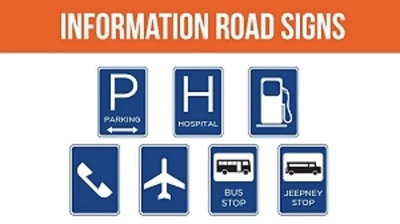An information sign is a sign that is used to inform people of the purpose of an object, give them instructions on the use of something, etc. An example is a traffic sign, such as a stop sign.
Information signs are important as communication tools; they help to indicate various hazards that are present in a plant site or workplace. At the same time, they warn workers to always keep watching out for those hazards by giving required information and safety instructions.
Shape and Colour of Information Sign
An information sign can take any shape and colour depending on the type of sign. For instance, the traffic sign or the stop sign, which are examples of an information sign, will take the shape and colour of the typical sign they represent.
Information signs have been growing in visibility due to the explosion of sign technologies. For hundreds, if not thousands, of years, signs were crafted out of wood. Words and images were then hand-painted on the sign. The other traditional way of creating signs dealt with individual constructed letters carved from wood, molded or wrought from metal, which were then individually placed in the appropriate sequence.
READ: 21 Important Road Signs You Must Understand
While both of these methods are still employed, technology has moved in around them. Woodworking machinery can now be controlled by computers, leading to much greater consistency. Molded signage has changed dramatically with the advent of plastics, which are far more flexible than metal, as well as significantly cheaper to produce. Additionally, altogether new sign technologies have come into being, such as computer-cut vinyl signage.
Types of Information Signs
Based on the definition of information signs, some types of information signs include:
- Traffic Signs: Direct motorists and pedestrians, indicating rules, warnings, and directions on roads.
- Warning Signs: Alert individuals about potential hazards or dangers, like slippery floors or high voltage areas.
- Instructional Signs: Provide specific guidance or instructions, such as exit signs, restroom signs, or operational instructions.
- Regulatory Signs: Communicate rules and regulations, often with specific requirements, such as speed limits or no parking zones.
- Safety Signs: Promote safety by indicating emergency exits, first aid stations, or locations of safety equipment.
- Prohibition Signs: Restrict certain activities or actions, like no-smoking signs or no-entry signs.
- Mandatory Signs: Indicate actions that must be taken, such as wearing safety gear or using a specific pathway.
- Informational Signs: Provide general information, such as maps, directories, or facility information.
- Symbolic Signs: Use symbols to convey messages without relying on text, ensuring universal understanding.
- Directional Signs: Guide people to specific locations, like arrows indicating the way to exits or different facilities.
Importance of Information Signs
Information signs are important as they aid in the following areas:
- Information signs warn of potential hazards, promoting safety by alerting individuals to dangers like slippery floors or electrical areas, reducing the risk of accidents.
- They convey crucial messages, instructions, and regulations, facilitating effective communication in public spaces, workplaces, and transportation systems.
- Information signs guide people to desired locations, reducing confusion and ensuring efficient navigation within buildings, campuses, or public areas.
- In cases of emergency, it indicates emergency exits, first aid stations, and safety equipment locations, aiding swift and organized responses during critical situations.
- Regulatory and prohibition signs communicate rules and restrictions, promoting adherence to regulations, whether related to traffic laws, workplace policies, or public spaces.
- Symbolic signs enhance universal understanding, transcending language barriers and ensuring that information is accessible to diverse populations.
- Informational signs, such as maps or directories, improve efficiency by helping people locate facilities, services, or points of interest, contributing to a smoother flow of activities in various environments.
Example of Information Sign
Here are some examples;








If you notice all the signs are putting out specific information that needs no much explanation; this is why they are called information signs.
In conclusion, information signs are signs placed in strategic locations to lead, guide, warn, or direct. Any sign that achieves these objectives forms an information sign; it should not be taken for granted or overlooked.
Related Articles
21 Very Important Road Signs And Their Meanings
What Are Mandatory Signs, and How To Identify Them
21 Important Safety Signs & Symbols And Their Meanings
